GNOME Trash for UD Sun Ray Terminals
There is a hidden trash folder for each filesystem (e.g., your home directory, a USB flash drive). The GNOME trash management system does not currently behave the way you might expect. This document will describe how to
- Locate your hidden trash folders
- Delete files permanently
- Retrieve files from your trash folders.
Your GNOME desktop
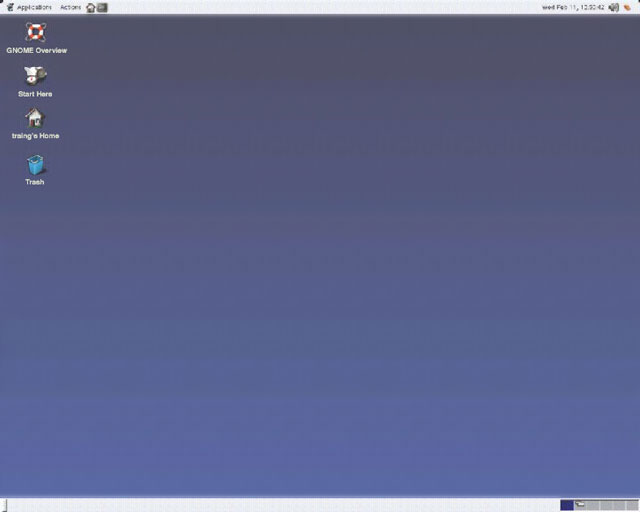
Your desktop is represented by the large blue area, and initially contains four icons:
GNOME Overview—General GNOME documentation. Start Here—Documentation on using GNOME and Sun Rays at UD. username's Home—Nautilus File Manager to open your home directory. Trash—Nautilus File Manager to open your trash folders.This document will focus on the the last two icons: username's Home and Trash.
Your home directory
Double-click the username's Home icon to display all files in your home directory within a Nautilus window. The files will be displayed as icons representing the types of files. To move a file to the trash, you can drag the file to the Trash icon on the desktop or right-click the file and select Move to Trash.The file will be moved to a hidden trash folder.
Desktop trash
Double-click the Trash icon on your desktop and a Nautilus window will open with the location named "trash:" in the text area. Unfortunately, this is not your home directory trash folder and will probably be empty. Dragging files and folders into the Trash icon will actually put the files and folders into a hidden trash folder.
Opening the hidden trash folders
The trash folder in your home directory is named .Trash. The trash folder on a shared drive, such as a USB flash drive, is named .Trash-username where username is your UDelNet ID.
Opening your home directory hidden trash folder
As illustrated below, double-click username's Home icon. Type:
/.Trashat the end of the text in the Go To: text area and press the RETURN key.
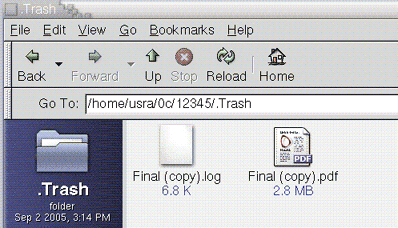
Once your home directory hidden trash folder is opened, you can bookmark it for quick access by selecting Bookmarks > Add Bookmark in the Nautilus window. You can subsequently open your home directory hidden trash folder by just selecting Bookmarks > .Trash in any Nautilus window.
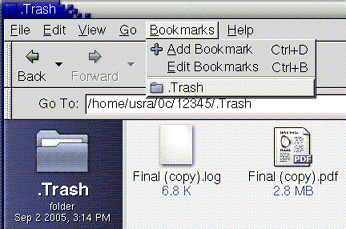
Opening your USB flash drive hidden trash folder
You can move files from your USB flash drive to the trash, just as you would files in your home directory. Drag them to the Trash icon on the desktop or right-click any file and select:
Move to TrashThe hidden trash folder is stored on your USB flash drive, not in your home directory. In the Nautilus window for your USB flash drive, type:
/.Trash-usernameat the end of the text in the Go To: text area and press the RETURN key. This is illustrated below.
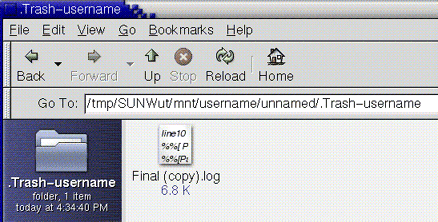
You can bookmark the USB flash drive trash folder as long as you do not change the name of your USB flash drive by selecting Bookmarks > Add Bookmark in the Nautilus window. Now, to open your USB flash drive hidden trash folder, simply select Bookmarks > .Trash-username in any Nautilus window.
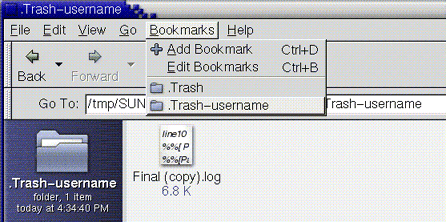
Emptying your trash folders
You must delete files from a trash folder to free up space on your filesystem. (Simply moving a file to a trash folder does not free up any space.) To empty your entire trash folder, select Edit > Select All Files followed by Edit > Delete from Trash in the trash folder Nautilus window.
Retrieving files from your trash folders
The trash system does not remember where the files came from originally. After opening a trash folder Nautilus window, open a second Nautilus window and navigate to the folder where you want to store the file. Drag the file from the trash folder to the destination folder.
Troubleshooting
My file or directory cannot be moved to a trash folder.
If the file or directory will not go into the trash then something has gone wrong. If the Nautilus file manager cannot find a hidden trash folder or cannot write to it then the file or directory is not moved. You may have a read-only disk or your USB flash drive may be write-protected. (Some flash drives have a switch which can be used to write-protect the data.) It is also possible to have problems with only some of the files on your flash drive. In this case, you should use a system other than a Sun Ray to delete the problem files on the flash drive.

